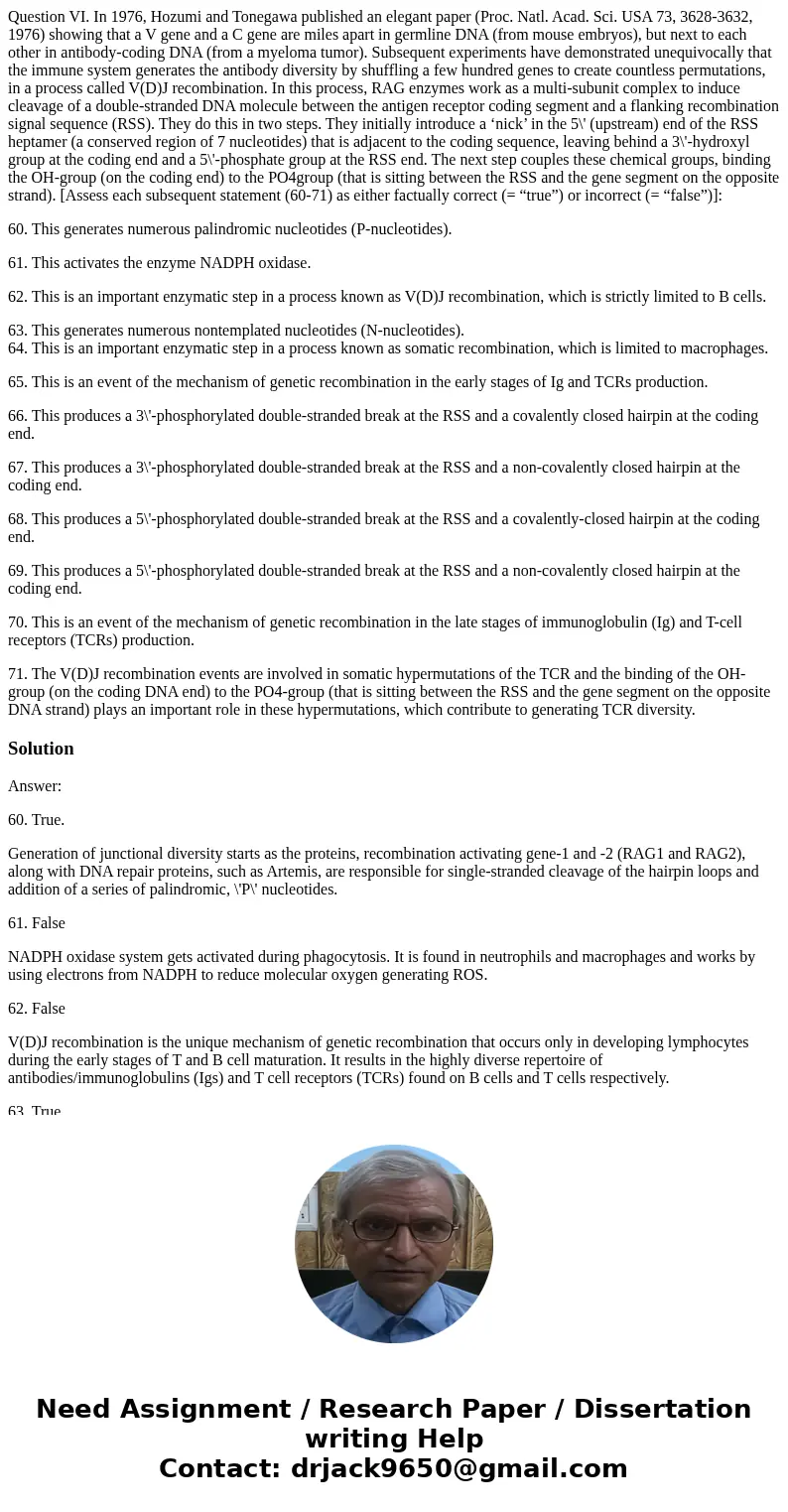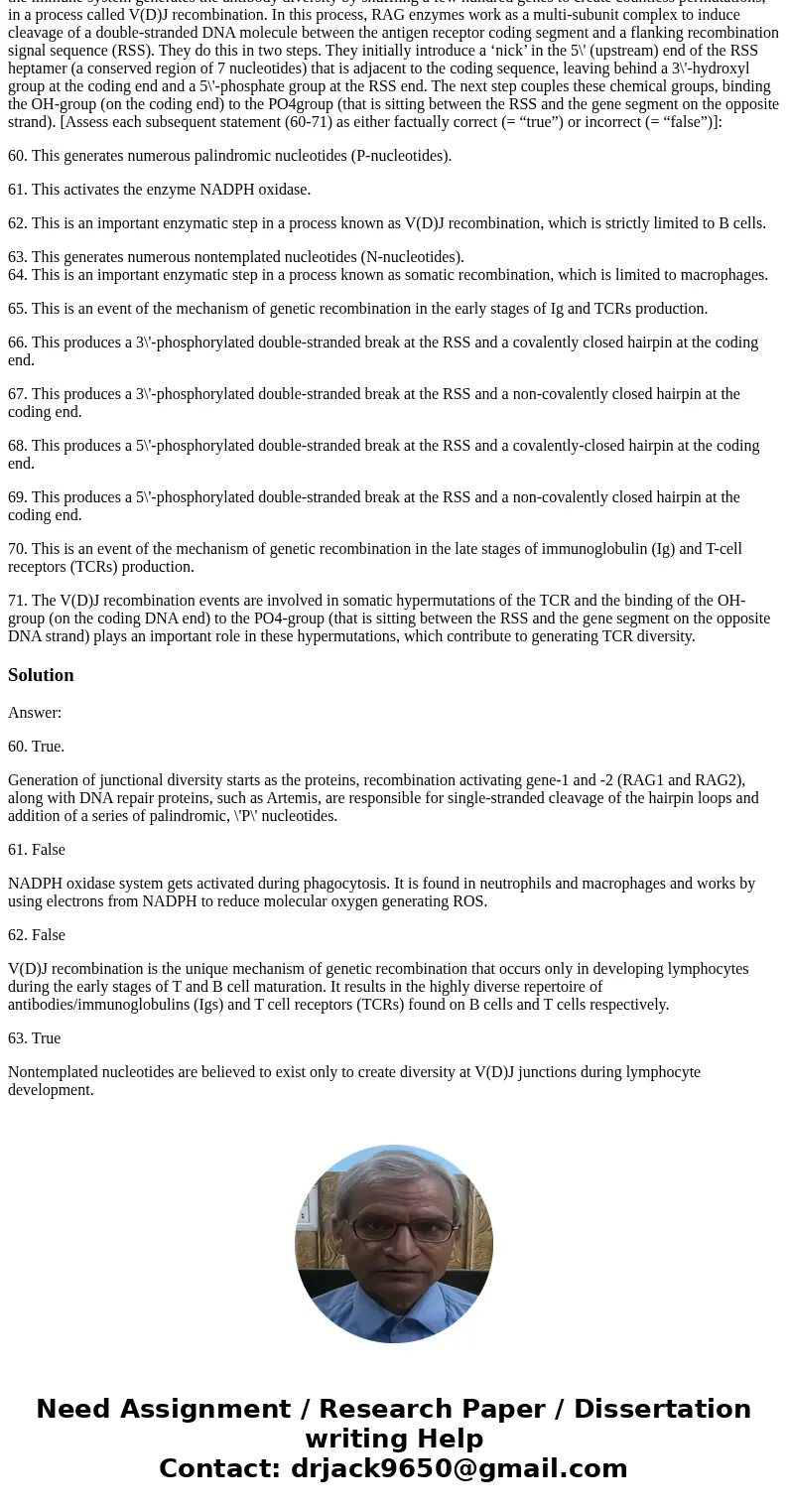Question VI In 1976 Hozumi and Tonegawa published an elegant
Question VI. In 1976, Hozumi and Tonegawa published an elegant paper (Proc. Natl. Acad. Sci. USA 73, 3628-3632, 1976) showing that a V gene and a C gene are miles apart in germline DNA (from mouse embryos), but next to each other in antibody-coding DNA (from a myeloma tumor). Subsequent experiments have demonstrated unequivocally that the immune system generates the antibody diversity by shuffling a few hundred genes to create countless permutations, in a process called V(D)J recombination. In this process, RAG enzymes work as a multi-subunit complex to induce cleavage of a double-stranded DNA molecule between the antigen receptor coding segment and a flanking recombination signal sequence (RSS). They do this in two steps. They initially introduce a ‘nick’ in the 5\' (upstream) end of the RSS heptamer (a conserved region of 7 nucleotides) that is adjacent to the coding sequence, leaving behind a 3\'-hydroxyl group at the coding end and a 5\'-phosphate group at the RSS end. The next step couples these chemical groups, binding the OH-group (on the coding end) to the PO4group (that is sitting between the RSS and the gene segment on the opposite strand). [Assess each subsequent statement (60-71) as either factually correct (= “true”) or incorrect (= “false”)]:
60. This generates numerous palindromic nucleotides (P-nucleotides).
61. This activates the enzyme NADPH oxidase.
62. This is an important enzymatic step in a process known as V(D)J recombination, which is strictly limited to B cells.
63. This generates numerous nontemplated nucleotides (N-nucleotides).
64. This is an important enzymatic step in a process known as somatic recombination, which is limited to macrophages.
65. This is an event of the mechanism of genetic recombination in the early stages of Ig and TCRs production.
66. This produces a 3\'-phosphorylated double-stranded break at the RSS and a covalently closed hairpin at the coding end.
67. This produces a 3\'-phosphorylated double-stranded break at the RSS and a non-covalently closed hairpin at the coding end.
68. This produces a 5\'-phosphorylated double-stranded break at the RSS and a covalently-closed hairpin at the coding end.
69. This produces a 5\'-phosphorylated double-stranded break at the RSS and a non-covalently closed hairpin at the coding end.
70. This is an event of the mechanism of genetic recombination in the late stages of immunoglobulin (Ig) and T-cell receptors (TCRs) production.
71. The V(D)J recombination events are involved in somatic hypermutations of the TCR and the binding of the OH-group (on the coding DNA end) to the PO4-group (that is sitting between the RSS and the gene segment on the opposite DNA strand) plays an important role in these hypermutations, which contribute to generating TCR diversity.
Solution
Answer:
60. True.
Generation of junctional diversity starts as the proteins, recombination activating gene-1 and -2 (RAG1 and RAG2), along with DNA repair proteins, such as Artemis, are responsible for single-stranded cleavage of the hairpin loops and addition of a series of palindromic, \'P\' nucleotides.
61. False
NADPH oxidase system gets activated during phagocytosis. It is found in neutrophils and macrophages and works by using electrons from NADPH to reduce molecular oxygen generating ROS.
62. False
V(D)J recombination is the unique mechanism of genetic recombination that occurs only in developing lymphocytes during the early stages of T and B cell maturation. It results in the highly diverse repertoire of antibodies/immunoglobulins (Igs) and T cell receptors (TCRs) found on B cells and T cells respectively.
63. True
Nontemplated nucleotides are believed to exist only to create diversity at V(D)J junctions during lymphocyte development.


 Homework Sourse
Homework Sourse